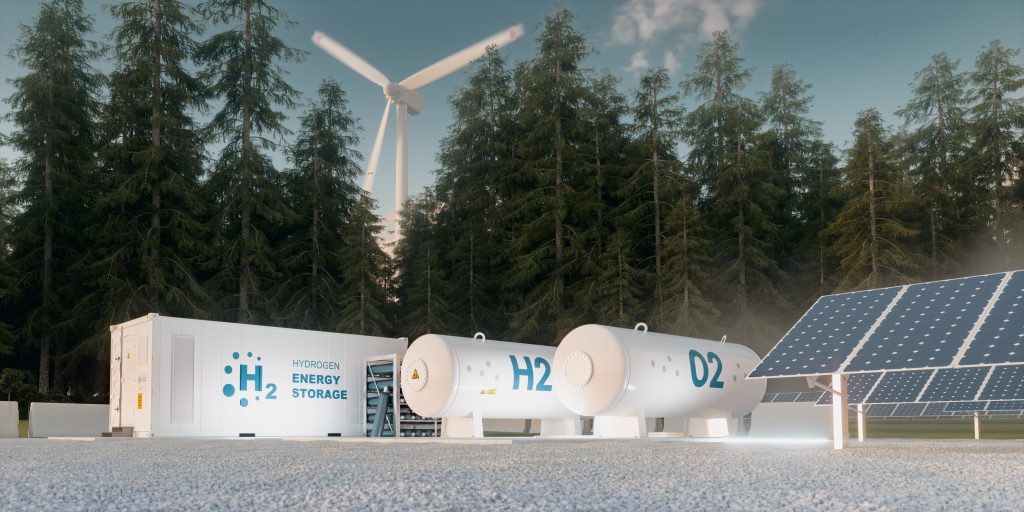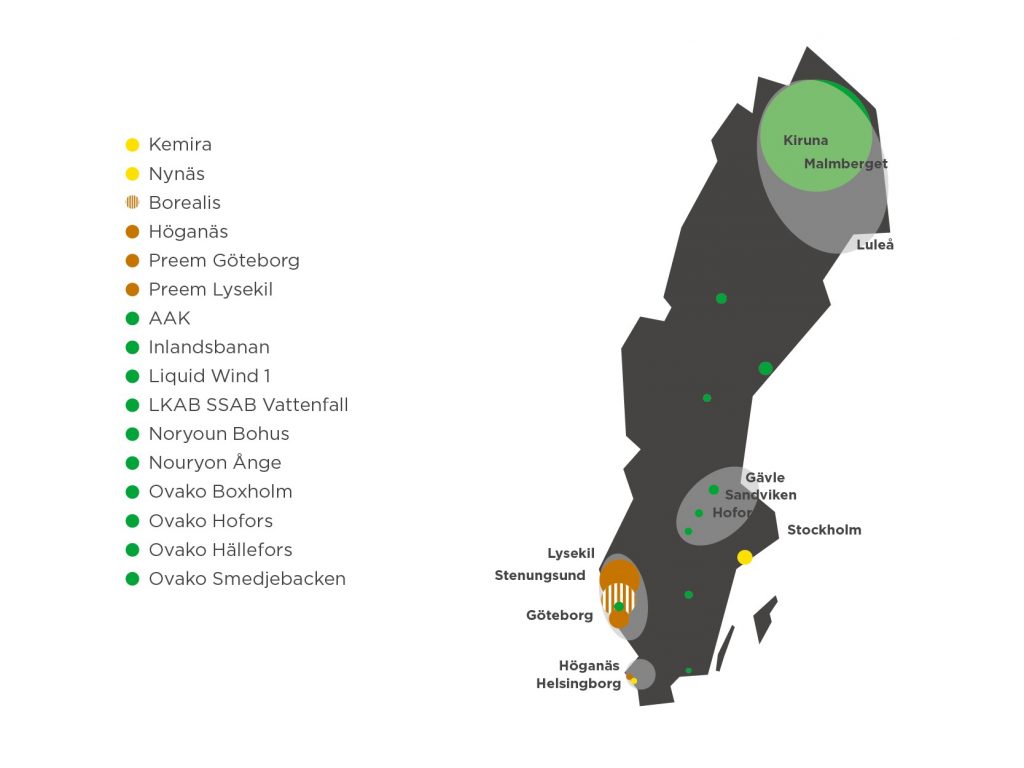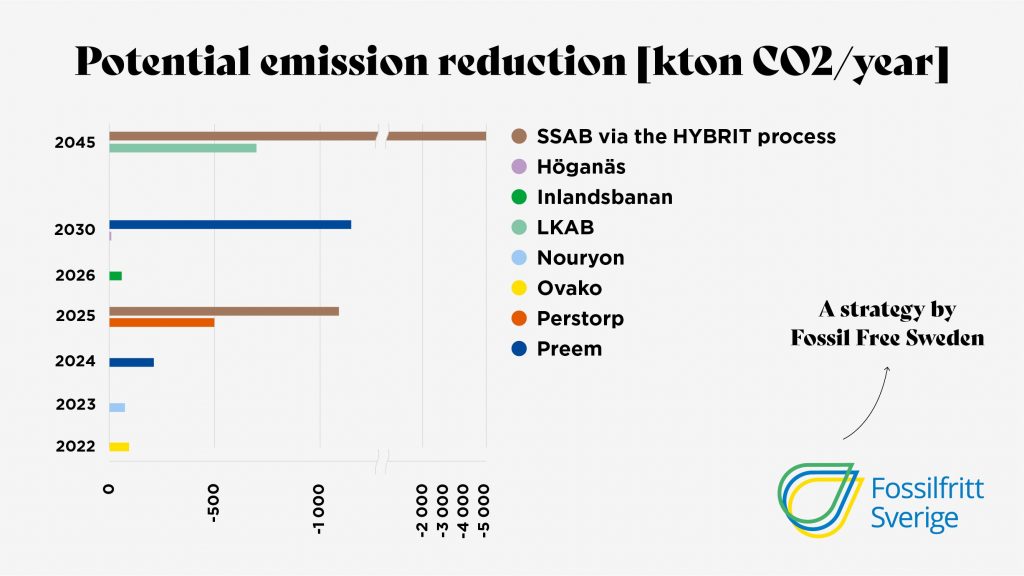
Hydrogen strategy
Hydrogen will play an important role for Swedish industry when implementing the 22 roadmaps for fossil-free competitiveness.
Fossil Free Sweden has developed a strategy to use hydrogen to achieve the climate goals but also with a focus on new industrial initiatives to create innovations, jobs and export products.
The strategy has been developed in cooperation with companies and other actors in the hydrogen value chain and contains policy recommendations for handling common challenges and to use the full potential of hydrogen.
Facts about hydrogen
Hydrogen can be produced from reforming fossil fuels (natural gas, coal), biomass (solid biofuel, organic waste, biogas) and by electrolysis from electricity that splits water.
At water electrolysis, hydrogen, oxygen and heat are produced.
The terms renewable hydrogen, clean hydrogen or green hydrogen refers to hydrogen produced from renewable energy or raw material. If hydrogen derived from nuclear power is included the term is pink or fossil-free hydrogen.
Fossil hydrogen or grey hydrogen is produced from fossil fuels.
Blue hydrogen is produced from fossil sources in combination with the capture of carbon dioxide, known as CCS technology (Carbon Capture and Storage).
The cost of renewable electricity production is declining worldwide and is expected to continue to fall. Electrolyte technology is also constantly improving and the cost of electrolysers is expected to be halved by 2030. Fossil-free hydrogen in Scandinavia is expected to be competitive with fossil hydrogen before 2030 and the proposal in the strategy is that only fossil-free hydrogen should be rewarded.
Expansion of the hydrogen infrastructure in the country can be accelerated by establishing cross-sectoral local and regional hydrogen clusters (Hydrogen Valleys). They can be established where existing industries use or will use hydrogen and where infrastructure such as ports and railways already exist.

There are currently a number of major industrial projects in Sweden, where the production and use of hydrogen is, or is planned, to be central to one or more new value chains. Several new initiatives and partnerships have been announced in 2020 and more are expected in 2021. Here are some examples:
- HYBRIT’s investment in fossil-free steel with hydrogen as a reduction agent, and LKAB’s major industrialisation of the same technology for carbon-free sponge-iron.
- Ovako is preparing the next demonstration step for steel heating using fossil-free hydrogen.
- Both Scania and Volvo AB invest in the development of hydrogen-powered trucks.
- Perstorp’s “Project Air”, where together with Fortum and Uniper, they are developing a unique process for sustainable methanol production by combining CCU (Carbon Capture and Utilisation) and gasification.
- Preem and St1 are planning increased biofuel production using fossil-free hydrogen.
- St1, Liquid Wind and Jämtkraft are preparing for various investments in electrofuels.
- Nouryon plans to replace fossil hydrogen with fossil-free hydrogen for its hydrogen peroxide production.
This hydrogen strategy shows that today’s known hydrogen projects in Sweden can achieve a reduction of 7,1 million tonnes of carbon dioxide per year in direct emissions by 2045. That equals 14 per cent of Sweden´s national emissions. Counting the emission reductions from customers using the products in Sweden it will amount to over 30 percent. Apart from that it will reduce emissions from customers in other countries. The carbon-free sponge-iron from LKAB could reduce emissions from customers in other countries by 30 million tonnes.

The electricity system is key to implementing hydrogen investments in several parts of Sweden. The planning goal for electrolysis effect of 8 GW the year 2045 that is suggested in the strategy would require about 55 TWh of electricity. In short term the electricity grid needs to be developed but in long term increased electricity production will also be needed.
A hydrogen infrastructure also needs to be developed, and since hydrogen pipelines are a relatively new type of infrastructure, new regulations are also needed.
A lot of investments are needed in hydrogen initiatives, and to start with they can result in higher costs than conventional investments. Therefore, the Government needs to contribute financing solutions and introduce various financial instruments so as to reduce the investment risk for companies.
In addition, research and development will continue to be important as hydrogen is introduced into the market. There is also a need for skills enhancement within government agencies and other actors in society in relation to the new technologies and systems required for this development.
Prioritized recommendations
- The Government should during 2021 instruct Svenska kraftnät (Swedish TSO) to develop an electricity grid plan that sets out which electricity lines are prioritised to enable industry to be electrified at a sufficiently high rate, and the timetable for laying the electricity lines.
- The Government should during 2021 appoint a committee that is tasked with handling regulatory barriers that hamper attempts at new solutions based on new technologies or existing technologies used in new ways in 2021, a decision should be made that at least three electrical lines can be included in trials. This is in line with the proposals of the Committee for Technological Innovation and Ethics (Komet).
- The Government should by 2022 set a planning goal to have 3 GW installed electrolysis capacity by 2030 and at least 8 GW by 2045 to enable fossil-free development in most sectors.
- The Government should therefore instruct the Energy Markets Inspectorate to create regulation with a revenue framework for hydrogen pipelines. The expansion of hydrogen pipelines should be subject to concessions issued by the Energy Markets Inspectorate in the same way as electricity lines.
- Review the law governing environmental permits so that the industries and energy establishments that already produce and use hydrogen on a large scale and who want to convert to a more climate-adapted production of hydrogen in the same closed industrial area only need to submit a change notification instead of currently having to apply for a new environmental permit.
- Starting in 2021, the Government should review the taxation of hydrogen, electrofuels and electrochemicals, including production, distribution and various applications.
- The Civil Contingencies Agency (MSB) should during 2021 draw up national advice and recommendations for handling hydrogen and hydrogen pipelines to be used by all rescue services and municipalities.
- The Government should carry out a fast-track study concerning production support for fossil-free hydrogen projects during an introductory phase through the Carbon Contract for Difference, a system in which central government provides support based on the project’s carbon reduction related to EU-ETS prices.
- The Government should during 2021 instruct the Swedish Energy Agency to draw up a call for proposals for regions in Sweden as demo-show rooms to test and demonstrate cross-sectoral hydrogen systems. The aim is to establish a couple of Swedish hydrogen clusters (“Hydrogen Valleys”).
- The Government should work towards increased coordination between agencies regarding permit issues linked to the hydrogen area, for example by appointing a coordinating agency.
- The Government should ensure that universities and other higher education institutions continue to establish areas of research and innovation in the field of fossil-free hydrogen.
See the presentation (in Swedish)
Companies that stands behind the strategy
Adesso BioProducts AB
Alfa Laval
Borealis Sverige
ElectriVillage, Mariestads Kommun
Energigas Sverige
Euromekanik AB
Fortum Sverige
GKN Aerospace Sweden AB
Höganäs AB
Inlandsbanan AB
Jämtkraft
Linde GAS Region Europe North
LKAB
Nilsson Energy
Nordion Energi
Ovako AB
Permascand AB
Plagazi AB
PowerCell Sweden AB
Preem
RISE Research Institutes of Sweden AB
AB Sandvik Materials Technology
Scania CV AB
Siemens Energy AB
Skellefteå Kraft
SSAB
St1 Sverige AB
Statkraft Hydrogen Sweden AB
Svea Vind Offshore
Uniper Sverige
Vattenfall
Volvo Group Truck Technology
Vätgas Sverige


